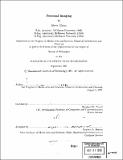Personal imaging
Author(s)
Mann, Steve, 1962-
DownloadFull printable version (46.91Mb)
Advisor
Rosalind W. Picard.
Terms of use
Metadata
Show full item recordAbstract
In this thesis, I propose a new synergy between humans and computers, called "Humanistic Intelligence" (HI), and provide a precise definition of this new form of human-computer interaction. I then present a means and apparatus for reducing this principle to practice. The bulk of this thesis concentrates on a specific embodiment of this invention, called Personal Imaging, most notably, a system which I show attains new levels of creativity in photography, defines a new genre of documentary video, and goes beyond digital photography/video to define a new renaissance in imaging, based on simple principles of projective geometry combined with linearity and superposition properties of light. I first present a mathematical theory of imaging which allows the apparatus to measure, to within a single unknown constant, the quantity of light arriving from each direction, to a fixed point in space, using a collection of images taken from a sensor array having a possibly unknown nonlinearity. Within the context of personal imaging, this theory is a contribution in and of itself (in the sense that it was an unsolved problem previously), but when also combined with the proposed apparatus, it allows one to construct environment maps by simply looking around. I then present a new form of connected humanistic intelligence in which individuals can communicate, across boundaries of time and space, using shared environment maps, and the resulting computer-mediated reality that arises out of long-term adaptation in a personal imaging environment. Finally, I present a new philosophical framework for cultural criticism which arises out of a new concept called 'humanistic property'. This new philosophical framework has two axes, a 'reflectionist' axis and a 'diffusionist' axis. In particular, I apply the new framework to personal imaging, thus completing a body of work that lies at the intersection of art, science, and technology.
Description
Thesis (Ph.D.)--Massachusetts Institute of Technology, School of Architecture and Planning, Program in Media Arts & Sciences, 1997. Includes bibliographical references (p. 217-223).
Date issued
1997Department
Program in Media Arts and Sciences (Massachusetts Institute of Technology)Publisher
Massachusetts Institute of Technology
Keywords
Architecture. Program in Media Arts and Sciences